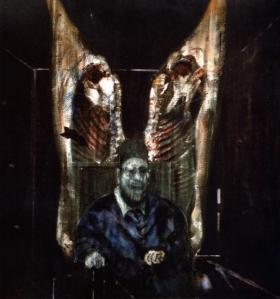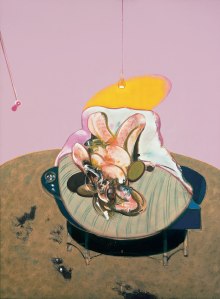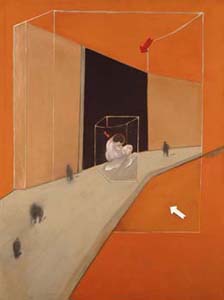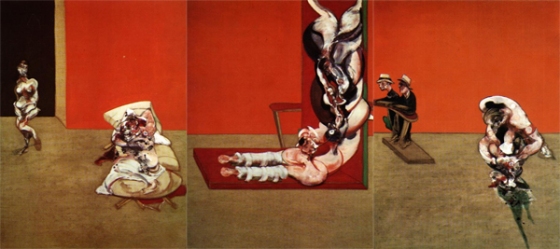According to Gilles Deleuze, painting is hysteria (45-6). Painting in the throes of hysterics attempts to go “beyond representation,” morphing “cerebral pessimism into nervous optimism,” and Bacon is an extemporary case of a hysteric painter because he clings neither to organic representation or complete abstraction, instead occupying a grey area between the two (Deleuze 45). Bacon exemplifies hysteria and is thus masterful at capturing a presence beneath appearances. This hysteria is being channeled by anxieties linked to the human condition not only in the sense of dealing with one’s inner self (see the vast quantity of fleshy imagery in Bacon’s works, such as Figure With Meat (1954), below), but one’s relation to the world. Freeland sees Bacon as an example of the cognitive theory — art as a language, blurring boundaries between representation and abstraction (154).
In this essay, I will argue that art can indeed convey philosophical messages by viewing the paintings of Francis Bacon through an existentialist lens. By “existentialist” I am referring to the system of thought that came into being in 20th century Europe stressing the actions of the individual (as a being-in-the-world who is distinguished by the fact they make an issue of their own being) as being the central means by which to interpret life’s significance. Existentialism stressed the tension between the individual and the society which he inhabited, as well recognition of the bountiful absurdity ruling the universe. Moreover, existentialists rebutted an essentialist viewpoint by asserting that existence preceded essence, or, that individuals weren’t defined by inherent properties, but instead their actions, which framed the way they were related to the external world. Bacon expresses his existential concerns using the ‘language’ of painting through a number of ways: emphasizing figure-ground relations, individual identity loss, confinement, and man as a physical organism. Moreover, Bacon’s art is of the category of non-mimetic realism, with surrealist influences, thus countering Plato’s idea of art as mimetic and unable to express philosophical thought because Bacon is able to convey such potent — if sometimes ambiguous — messages through his grotesque imagery.
Evidence
Bacon’s paintings illustrate the existential concept of the figure-ground relationship. There is a disjunction of figure and ground in Bacon’s painting, most striking in his works where the object of focus is so detached from their background, such as in plate 2. The backgrounds are often flat landscapes nondescript outside of their vibrant colors, and both containing and serving as a frame for their subjects; despite their often lively hues, it is clear the viewer’s eye is meant to be drawn to the figure or figures painted, although there are sometimes objects not immediately in the foreground that draw attention, such as the painted photo within Lying Figure (1969), below.
Referring to Bacon’s paintings Schmied writes, “the sense of conflict is gleefully amplified through the colour” utilized in the background of the “damaged” bodies on display (89). There is abundant dissociation between people and the objects that surround them, thus suggesting that there is a vast divide between man and the physical reality surrounding him, provoking further inquiry into the roots of alienation. Schmied sees the separation of figure and ground, displayed prominently in paintings such as Statue and Figure in the Street (1983), seen below, as perhaps the most distinguishing feature of Bacon’s style, hinting at themes of “strangeness and foreignness” (89). But Schmied fails to take into account the psychological intricacies this suggests for Bacon’s figures; he dwells merely on spatial relations, failing to scratch below the surface. Such a contrast between figure and background suggests an unease and isolation of being-in-the-world, an imposition of a figure uncomfortable with their existence upon an alien background that is of secondary importance and focus. Such analysis is reminiscent of Heidegger, who said that being must be clarified before anything else (213). Such a disjunction also incorporates Sartre’s idea of negation. Sartre said that while existential freedom relies upon negation, “negation will never be derived from being,” and while Bacon is certainly providing a sharp contrast between his figures and their background, visually bringing into focus the philosophical idea of figure-ground (317).
Identity loss is a prevalent theme in Bacon’s paintings, and he expresses philosophical themes through this. Bacon stresses existential issues like identity loss with the blurring of faces in his paintings. Even when an object of focus’ body is clearly portrayed, their face is always distorted. This seems to suggest an unease of expressing individual identity within the comfort of one’s own physical being. Deleuze says Bacon dismantles the face of the figure to “rediscover the head” (19). Existentialists were preoccupied with the loss of control over identity the individual suffered in the face of societal forces which were often absurd in and of themselves. Bacon’s dismantling of the face in his figures suggests an erasing of certainty in their identities. Moreover, the screams of agony painted across some of the more distinguishable faces seem to express a gut-wrenching agony due to the horrid state of their confined situation, as in the case of Figure with Meat featured at the beginning of this post.
Individual confinement is an additional issue brought up in Bacon’s art and he is able to convey existential anxiety through his works. There is a common theme running through the paintings of figures being confined within boxes or contraptions. The figures portrayed in Bacon’s paintings are being confined and trying to escape (Deleuze). An exemplary case of this is Study of Velasquez’s Portrait of Pope Innocent X (1953), in which Bacon has painted an interpretation of the classic painting, making the pope look as if he is screaming in agony and fading away into the black background, as well as being confined both to his bright golden throne as well as being surrounded by a similar gold cage.
This painting seems to exhibit themes of angst and confinement and seems to satisfy the notion that, contrary to what Plato says in the Republic, art can introduce philosophical ideas. Statue and Figure in the Street is another interesting case because it seems to be the painting in which Bacon is most explicit about confinement of the figure: not only is the figure contained within a box with a circle around his head, but he is contained within other concentric boxes, and there are arrows pointing in his direction and smaller, blurred figures walking near him, suggesting a tension between individual and society. A number of Bacon’s paintings also exhibit figures contained within boxes, appearing either to be struggling to break free or mortified by their condition.
Bacon portrays humans as meat, and by doing so prompts reflection on the animal nature of man as well as the emotional response such grotesqueness provokes, which reaches to the core of man’s sentiment about his own existence as a physical being. In Bacon’s art, man is “coupled with his animal” in a “zone of indiscernibility or undecidability,” and it is shown how inextricably humanity is linked to the primal figures in its shadow (Deleuze 16). Loeb states that Bacon explores the theme of animal instincts confined by society, which seeks to contain the individual’s drives (21 Feb. 2011). I feel like this is a useful foundation for understanding Bacon’s framing of humans as animals, yet it is not comprehensive enough. Bacon is turning the human beings he portrays into “slabs of raw meat,” as Freeland says (150-1), and by doing so he emphasizes not only the physical, animal aspects of humanity, but seeks to provoke a feeling of disgust in the viewer of his works, driving us deeper into understanding his paintings by capturing our attention. Bacon intends to provoke an emotional response (Schmied 55). But instead of aiming for sentimentality he is driven by disgust (Loeb 21 Feb. 2011). By confronting the viewers of his art with their own meaty physicality (see Crucifixion triptych (1965) bel0w), Bacon prompts an exploration of their own raw corporeal being. He is not only portraying the confinement of animal drives, but also the disgust with which we view our own animalistic being, the ground for our own figure of individuality, meaning we cannot understand our own unique cerebral qualities without first recognizing then negating our physical humanness.
Bacon’s art thus emanates philosophical messages, proving art can communicate philosophical thought, specifically of an existential nature in his case. Existential thought is based upon focus on the individual’s life through action and experience. By viewing Bacon’s paintings through an existential lens one can better seek to interpret the significance of the themes portrayed, and why they provoke such an emotional response for the viewer.
Objections
A formalist interpretation of Bacon’s artwork offers an objection to the cognitive view of his art. While the cognitive view says that his art is like a language expressing ideas, a formalist approach draws its interpretation not from the artist’s personal past (as does psychobiographical) or feelings in the artist transmitted via the art (an expression theory) but instead looking at the artwork itself, considering its formal elements, like color. Bacon insisted his work was only about painting (Freeland 152). He was unwilling to concede that political, personal, and philosophical messages were being transmitted through his work. Trying to interpret philosophical thought from artwork is tantamount to over-analysis: Bacon is merely offering a visual arena for the viewer’s eye to partake; there is no statement of the absurdity of the human condition or the facets in which the struggle against such absurdity is framed.
Rebuttals
As Freeland says, in agreement with Dewey, “art is a cognitive enterprise,” expressing thoughts to audiences (175). A formalist view of art seems to be superficial and doesn’t take into account the artist’s underlying mental situation or the thoughts the artwork can espouse in the viewer. The response to Bacon’s assertion that his art should be looked at with a formalist view is two-pronged. Firstly, such an assertion can be seen as a deceptive smokescreen to cover the artist’s intentions, making Bacon an unreliable source (Loeb 21 Feb. 2011). In addition, I would have to take the position of an interpretive aesthetic consequentialist, meaning it doesn’t necessarily matter if the artist intended for a certain thought or feeling to shine through, for there’s no reason for the viewer to read their mind or understand their intentions, what matters is what the viewer perceives as the messages in the art. Content is inextricably linked to an artwork’s formal elements.
Conclusion
Rather than trying to focus on major events in his paintings, Bacon largely preferred to give trivial events meteoric significance, focusing on the despair of the modern man — death, existential nausea, loneliness (Schmied 7). Following an expressionist approach, if feelings are linked to art and the artist that creates it, and Bacon’s art resonates with the same anxiety as portrayed and explored by existentialists, then Bacon is expressing an existential philosophy through his art. Seeking such emotional responses in his viewers prompts introspection in the parties affected, because while they are reactions to an external force, emotional responses tell us a great deal about ourselves. In turn, such inward reflection is then related outward at the world, toward one’s existential situation in relation to the external world. Considering the abrupt responses of surprise, disgust, and confusion Bacon’s art conveys, I consider him successful in communicating the existential unease of the figures he paints, if not himself.
Works Cited
Deleuze, Gilles. Francis Bacon: The Logic of Sensation. Minneapolis: U. Minn., 2003.
Freeland, Cynthia. But is it Art? Oxford: OUP, 2001.
Heidegger, Martin. “Selection from Being and Time.” Existentialism: Basic Writings. Eds. Guignon and Pereboom. New York: Hackett, 2001.
Loeb, Paul. Class Lectures. 21 Feb. 2011. University of Puget Sound.
Plato. “Against Imitation.” Aesthetics: A Reader in Philosophy of the Arts. Eds. Goldblatt and Brown. New York: Prentice Hall, 1996.
Sartre, Jean-Paul. “Selection from Being and Nothingness.” Existentialism: Basic Writings. Eds. Guignon and Pereboom. New York: Hackett, 2001.
Schmied, Wieland. Francis Bacon. Munich: Prestel, 2006.





Pingback: I love my Bacon | Something, Everything
I spent Christmas with Francis Bacon:
Pingback: good read guys should check it out | Scott chrishop